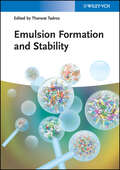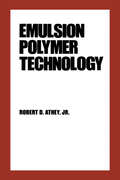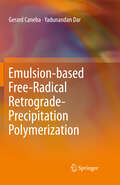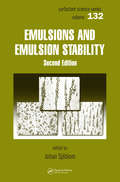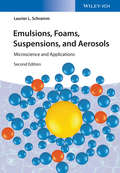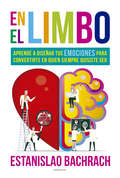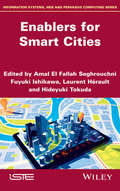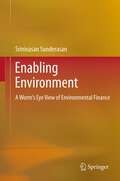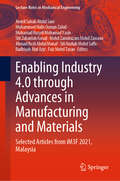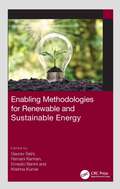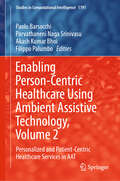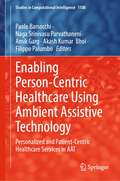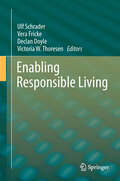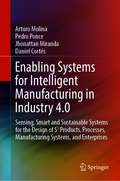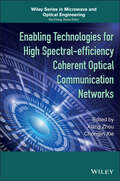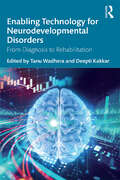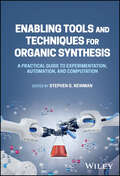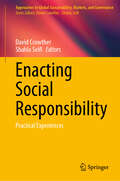- Table View
- List View
Emulsion Formation and Stability
by Tharwat F. TadrosThe importance of emulsification techniques, their use in the production of nanoparticles for biomedical applications as well as application of rheological techniques for studying the interaction between the emulsion droplets is gathered in this reference work.Written by some of the top scientists within their respective fields, this book covers such topics as emulsions, nano-emulsions, nano-dispersions and novel techniques for their investigation. It also considers the fundamental approach in areas such as controlled release, drug delivery and various applications of nanotechnology.
Emulsion Polymer Technology (Plastics Engineering)
by Bo Hu Robert D. Athey Anthony WangAn explanation for engineers and chemists working in such industries as paper, paint, and textiles, of the operating mechanisms involved in the physics and chemistry of polymers and colloids as they apply to emulsion polymer manufacture and use. Outlines the various available materials, how they are
Emulsion-based Free-Radical Retrograde-Precipitation Polymerization
by Gerard Caneba Yadunandan DarThis monograph is a follow-up material to the first FRRPP book by Gerard Caneba in 2009. It includes additional conceptual results, implementation of the FRRPP process in emulsion media to produce various block copolymers, and other FRRPP-related supplementary topics. Conceptual topics include the application of the quantitative analysis presented in the first FRRPP monograph for the occurrence of the FRRPP process to the polysterene-styrene-ether (PS-S-Ether) and poly(methacrylic acid)-methacrylic acid-water (PMAA-MAA-Water) systems, as well as extensions through unsteady state analysis of the occurrence of flat temperature profiles. Also, the generalization of the quantitative analysis is done to consider molecular weight effects, especially based on changes of the phase envelope to an hourglass type. Topics in implementation of the FRRPP process from pre-emulsions of monomers and the solvent/precipitant are highlighted. Additional FRRPP topics are included in this monograph that pertain to more recent efforts of Gerard Caneba, such as oil spill control, oil dispersant system, and caustic sludge remediation from emulsion-based FRRPP materials, hydrolysis of vinyl acetate-acrylic acid-based copolymers, and other polymer modification studies from FRRPP-based emulsions.
Emulsions and Emulsion Stability: Surfactant Science Series/61 (Surfactant Science)
by Johann SjöblomEmulsions and Emulsion Stability, Second Edition provides comprehensive coverage of both theoretical and practical aspects of emulsions. The book presents fundamental concepts and processes in emulsified systems, such as flocculation, coalescence, stability, precipitation, deposition, and the evolution of droplet size distribution.The bo
Emulsions, Foams, Suspensions, and Aerosols
by Laurier L. SchrammThis is the first book to provide an integrated introduction to the nature, formation and occurrence, stability, propagation, and uses of the most common types of colloidal dispersion in the process-related industries. The primary focus is on the applications of the principles, paying attention to practical processes and problems. This is done both as part of the treatment of the fundamentals, where appropriate, and also in the separate sections devoted to specifi c kinds of industries. Throughout, the treatment is integrated, with the principles of colloid and interface science common to each dispersion type presented for each major physical property class, followed by separate treatments of features unique to emulsions, foams, or suspensions. The first half of the book introduces the fundamental principles, introducing readers to suspension formation and stability, characterization, and fl ow properties, emphasizing practical aspects throughout. The following chapters discuss a wide range of industrial applications and examples, serving to emphasize the diff erent methodologies that have been successfully applied. The author assumes no prior knowledge of colloid chemistry and, with its glossary of key terms, complete cross-referencing and indexing, this is a must-have for graduate and professional scientists and engineers who may encounter or use emulsions, foams, or suspensions, or combinations thereof, whether in process design, industrial production, or in related R&D fields.
Emulsions, Microemulsions and Foams (Soft and Biological Matter)
by Dominique LangevinThis book takes an interface science approach to describe and understand the behavior of the dispersions we call emulsions, microemulsions and foams. The one thing all these dispersions have in common is the presence of surface-active species (surfactants) adsorbed at the interfaces between the two fluid phases that make up the emulsions, microemulsions or foams. The interfacial layers formed by the surfactants control most of the properties of the dispersions. The book describes the properties of interfacial layers, thin films and bulk fluids used in the elaboration of the various dispersions and it explains how such properties relate to the dispersion properties of these soft matter systems: structure, rheology and stability. These dispersion properties are far from being fully understood, in particular foam and emulsion stability. In discussing the state of the art of the current knowledge, the author draws interesting parallels between emulsions, microemulsions and foams that enlighten the interpretation of previous observations and point to a deeper understanding of the behavior of these materials in the future.
Emulsions: From Single Interfaces to Applications (Progress in Colloid and Interface Science)
by Reinhard Miller and Eduardo Guzmán-SolísThis book presents a comprehensive investigation of the complex scientific principles and practical applications of emulsions, offering valuable references for researchers, industry professionals, and advanced students in the fields of physical chemistry, material sciences, and engineering. The book is structured in three sections, which allow the readers to explore the fundamental principles of interfacial phenomena, the methodologies for emulsion preparation, and the diverse applications of emulsions in various industrial branches in depth.The initial section establishes the fundamental principles, with a particular focus on the physico-chemical characterization of interfaces pertinent to emulsion stabilization. The book meticulously examines several topics, including adsorption dynamics, particle-laden interfaces and thin liquid films. It supports these discussions with a combination of experimental techniques and theoretical insights. The second section shifts focus to the practical aspects of emulsion production, examining state-of-the-art methods, the role of stabilizers, and strategies for enhancing their stability, including innovations in nanoemulsions and aqueous two-phase systems. The final section presents several real-world applications, demonstrating the significant role that emulsions play in a number of fields, including the petroleum industry, pest control and pharmaceutical formulations.This text, featuring contributions from leading experts, synthesizes foundational knowledge and cutting-edge research, thereby bridging the gap between theory and practice. With an interdisciplinary scope, the book addresses both academic and industrial perspectives, and is therefore an indispensable addition to the library of anyone working with emulsions. It provides the tools and understanding required to advance work in the development of new materials, optimization of formulations, and investigation of the mechanics of interfacial systems.
Emulsion‐based Encapsulation of Antioxidants: Design and Performance (Food Bioactive Ingredients)
by M. Ali AboudzadehThe limited aqueous solubility of bioactive pharmaceutical ingredients presents a tremendous challenge in the development of new drugs. In recent years, methods have been developed to protect these sensitive bioactive compounds, namely antioxidants, with the aim of increasing the public sanitation grades. Emulsion-based systems are particularly interesting as colloidal delivery encapsulation systems, because they can easily be created from food-grade ingredients using relatively simple processing protocols. It is one of the most favorable delivery systems to increase the solubility of phytochemicals, nutraceuticals and food additives.Emulsion‐based Encapsulation of Antioxidants: Design and Performance advances the field of colloid science through the investigation of the effects of formulation and process parameters that influence emulsion production. The book offers a deeper comprehension of the technological and biological aspects of the incorporation of encapsulated compounds in food matrices and explication of their activity. Chapters provide an overview of the status of emulsion-based formulations to encapsulate antioxidants, fabrication, properties, applications, and biological fate with emphasis on systems suitable for utilization within industry. Special emphasis is placed on the antioxidant activity of the carriers being the key advantage of these emulsion-based systems. The main aim of the book is to inspire and to guide fellow scientists and students in this field. Filled with illustrations, figures, case studies, practical examples, and historical perspectives, the book can also be used as a practical handbook or graduate textbook. For industry professionals, the book presents easy-to-achieve approaches to industrial pharmaceutical production.
En busca de Venus
by Andrea WulfEl emocionante relato de cómo los científicos ilustrados se unieron para medir las profundidades del universo. Durante dos días en 1761 y 1769, cientos de científicos de países europeos y de las colonias norteamericanas apuntaron sus telescopios hacia el cielo para observar un raro acontecimiento astronómico: el tránsito de Venus por delante de la superficie del Sol. Fueron enviados a los rincones más remotos de nuestro planeta para observar el encuentro celeste, que permitiría calcular el tamaño del sistema solar. En busca de Venus narra de manera extraordinaria la vida de las personas que se embarcaron en esta compleja y esencial aventura y nos ofrece un vívido retrato de las contribuciones y el entusiasmo que hubo detrás de la primera colaboración científica internacional, pero también nos presenta las rivalidades y los acontecimientos políticos que fueron obstaculizando cada paso de la investigación. Un libro rebosante de acción y detalles maravillosos que nos revela el espíritu de la Ilustración y la eterna obsesión del ser humano por entender el mundo. La crítica ha dicho...«Una aventura cautivadora. El maravilloso ojo de Wulf para los detalles y su talento a la hora de volver accesibles las complejidades científicas hacen de este libro una lectura muy recomendable.»San Francisco Chronicle «Un libro que tanto los astrofísicos como los poetas pueden comprender.»The Boston Globe «Apasionante. Sin duda será uno de los libros de no ficción del año. No se pierdan esta maravillosa obra.»The Daily Mail «Una historia seductora. La sensibilidad de Wulf para entender las personalidades y su atención tanto a los registros científicos como a los diarios de los astrónomos dan vida a sus hazañas como exploradores, pero también como aventureros.»The Washington Times «Un estupendo ejemplo de narración científica. Relatado con elegante pericia.»The Times «Una historia muy humana y una entusiasta invitación a la exploración del universo por placer.»The Daily Telegraph «Magistral. Wulf relata la impresionante transformación de Venus de objeto de asombro mitológico a instrumento para la revelación científica.»The Guardian «Emocionante. Wulf cuenta una historia cautivadora y fascinante.»The Independent
En el limbo: Aprendé a diseñar tus emociones para convertirte en quien siempre quisiste ser
by Estanislao BachrachCon Ágilmente Estanislao Bachrach puso de moda la neurociencia. Con En el limbo -luego de años de investigación- el divulgador científico más lúcido de la década nos presenta una nueva teoría sobre las emociones que barre por completo con los viejos conceptos que aún hoy intentan imponer los ensayos de autores que repiten viejas fórmulas. Este libro te va a acompañar al limbus, al límite, al borde de tu zona de confort. Porque vos podés convertirte en la persona que siempre quisiste ser. Sin duda son las emociones las que hacen que vivir valga la pena. Todos atravesamos diversos estados emocionales a lo largo de la vida y muchas veces sentimos que nos dominan. No solo no los podés evitar sino que son fundamentales a la hora de tomar decisiones. Tanto si querés ser un líder o una mejor persona, es clave que conozcas, entiendas y regules tus emociones. Sin embargo, te han enseñado muy poco sobre ellas. Pero aquí la gran noticia: si bien experimentás emociones sin esfuerzo consciente, eso no significa que seas un receptor pasivo de estas experiencias. A pesar de tu historia las podés rediseñar empleando tus pensamientos, modificando el contexto y conociendo cada vez mejor tu cuerpo. Tus emociones te aportan información sobre tu bienestar. Son datos, no direcciones. En el limbo es una herramienta esencial de autoconocimiento científico para que aprendas a utilizar tus emociones en beneficio propio. Este libro te enseñará que cualquier habilidad puede ser desarrollada. Es importante que dejes de negar u omitir una emoción y que te preguntes qué es lo que está tratando de decirte. Vos sos el dueño de tus emociones, podés diseñarlas y así diseñar tu propia vida.
En nu online...
by Sibrenne Wagenaar Joitske HulseboschOnline leren en faciliteren met sociale media, zoals twitteren, bloggen en wiki-en.
EnCambio: Aprendé a modificar tu cerebro para cambiar tu vida y sentirte mejor
by Estanislao Bachrach"Este año cambio de trabajo, empiezo el gimnasio, bajo esos kilitos de más, aprendo un idioma nuevo"Cambiar. Esa es la cuestión.A veces te da tanto miedo no lograrlo que ni siquiera lo intentás. Te decís que sos así, que ya no podés cambiar.Vivís en piloto automático, reaccionando a las diversas situaciones del día a día casi sin pensar. Algunos de estos comportamientos te hacen eficiente, pero otros son detractores de eso que querés hoy para vos.Esto no es casual. No sos vos, es tu cerebro. Estas reaccionesautomáticas son determinadas por patrones cerebrales que vasconstruyendo a lo largo de tu vida.EnCambio te va a permitir alumbrar los procesos por los cuales pensás, sentís y te comportás de determinada manera, y así dejar atrás aquellos hábitos y conductas que ya no te sirven. El objetivo es que aprendas el potencial que tiene tu cerebro para cambiar y la capacidad que tenés vos para modificarlo.En este libro encontrarás la forma de conocerte mejor, paso fundamental para lograr un mayor bienestar, y las herramientas para que puedas cambiar pensamientos, emociones y acciones que entorpecen la vida que querés, con el fin de conseguir objetivos a largo plazo, personales y profesionales.Con ÁgilMente, Estanislao Bachrach llevó el conocimiento científico del cerebro a la vida cotidiana de miles de lectores. EnCambio lo instala definitivamente como el gran divulgador de la biología de nuestro órgano más complejo y preciado.
Enablers for Smart Cities
by Fuyuki Ishikawa Hideyuki Tokuda Amal El Seghrouchni Laurent HéraultSmart cities are a new vision for urban development. They integrate information and communication technology infrastructures - in the domains of artificial intelligence, distributed and cloud computing, and sensor networks - into a city, to facilitate quality of life for its citizens and sustainable growth. This book explores various concepts for the development of these new technologies (including agent-oriented programming, broadband infrastructures, wireless sensor networks, Internet-based networked applications, open data and open platforms), and how they can provide smart services and enablers in a range of public domains. The most significant research, both established and emerging, is brought together to enable academics and practitioners to investigate the possibilities of smart cities, and to generate the knowledge and solutions required to develop and maintain them.
Enabling Environment
by Srinivasan SunderasanEnabling Environment is as real as it gets. The global commons are jointly owned and their inhabitants are jointly obligated to ensure their preservation. In the face of protracted negotiations, convoluted documentation, discord, and incessant bickering among scientists, activists, pressure groups of various hues, politicians and negotiators, very often the people on the ground are ignored or taken for granted. In the meantime, life meanders along. It is these 'everyday individuals' who make consumption-related choices on their lifestyles, travel or on preferring certain products or services over others. Enabling Environment puts the individual front and center. Ecosystem services need to be recognized, appropriately priced and the costs allocated to the agents concerned. Enabling Environment is about defining economic and non-economic incentive structures and utilizing them to arrive at pro-environmental outcomes. This collection of articles illustrates the use of existing social, economic and regulatory structures, and the financial architecture and instruments, suitably modified or extended, to help internalize the environmental externality.
Enabling Immobilities: Social and Spatial Implications for Urban Planning (SpringerBriefs in Applied Sciences and Technology)
by Giovanni LanzaThis book presents a novel perspective on immobility, a topic often overlooked in urban planning and transport studies. It argues that conceptualizing, measuring, and analyzing the diverse forms in which individual immobilities manifest can provide crucial insights for designing more inclusive and sustainable planning policies. Immobility is here framed as a relative condition, where individuals experience reduced movement across time and space compared to others. While mobility is often seen as essential for social inclusion, this book challenges the notion that immobility is inherently negative. Instead, it positions immobility as not only the result of specific personal or spatial constraints but also as a reversible, voluntary choice to reduce daily travel. This choice can be influenced by the level of accessibility and proximity to valued spatial opportunities and can yield significant socio-environmental benefits. The book introduces an innovative framework that integrates immobility into urban planning theory and practice. Through case studies, it addresses four main operational challenges to foster a deeper understanding of immobility’s social and spatial implications: the measurement of immobility, the analysis of spatial conditions that facilitate chosen immobility, the exploration of the lived experiences of immobility, and the examination of planning policies that can promote reversible immobility to advance social inclusion and sustainability. By examining immobility in both its constrained and reversible forms, the book contributes to broader debates on how to achieve inclusion, sustainability, and accessibility through planning.
Enabling Industry 4.0 through Advances in Manufacturing and Materials: Selected Articles from iM3F 2021, Malaysia (Lecture Notes in Mechanical Engineering)
by Muhammed Nafis Osman Zahid Amiril Sahab Abdul Sani Mohamad Rusydi Mohamad Yasin Faiz Mohd Turan Siti Zubaidah Ismail Mohd Zairulnizam Mohd Zawawi Ahmad Rosli Abdul Manaf Siti Nadiah Mohd Saffe Radhiyah Abd AzizThis book presents part of the proceedings of the Manufacturing and Materials track of the iM3F 2021 conference held in Malaysia. This collection of articles deliberates on the key challenges and trends related to manufacturing as well as materials engineering and technology in setting the stage for the world in embracing the Fourth Industrial Revolution. It presents recent findings with regard to manufacturing and materials that are pertinent toward the realizations and ultimately the embodiment of Industry 4.0, with contributions from both industry and academia.
Enabling Methodologies for Renewable and Sustainable Energy
by Krishna Kumar Gaurav Saini Ramani Kannan Ernesto BeniniThis book aims to provide practical aspects of, and an introduction to, the applications of various technological advancement tools, such as AI, machine learning to design, big data, cloud computing, and IoT, to model, characterize, optimize, forecast, and do performance prediction of renewable energy exploitation. It further discusses new avenues for energy sources such as hydrogen energy generation and energy storage technologies including existing policies and case studies for a better understanding of renewable energy generation. Features: Covers technologies considered to explore, predict, and perform operation and maintenance of renewable energy sources. Aids in the design and use of renewable energy sources, including the application of artificial intelligence in a real-time environment. Includes IoT, cloud computing, big data, smart grid, and different optimization techniques for resource forecasting, installation, operation, and optimization of energy. Discusses the principle of integration/hybridization of renewable energy sources along with their optimization based on energy requirements. Reviews the concepts and challenges involved in the implementation of smart grids. This book is aimed at researchers and graduate students in renewable energy engineering, computer and mechanical engineering, novel technologies, and intelligent systems.
Enabling Person-Centric Healthcare Using Ambient Assistive Technology, Volume 2: Personalized and Patient-Centric Healthcare Services in AAT (Studies in Computational Intelligence #1191)
by Akash Kumar Bhoi Paolo Barsocchi Filippo Palumbo Parvathaneni Naga SrinivasuThis book focuses more on the transformative impact of person-centric health care, where it explores cutting-edge advancements in integrating artificial intelligence and machine learning to deliver personalized and efficient care. Key topics include the application of predictive models for critical health conditions such as brain stroke, lung cancer, diabetes, and Alzheimer's, as well as the integration of secure frameworks to protect sensitive patient data. The book also covers advanced techniques for recognizing human activities in ambient environments, optimizing patient data clustering, and evaluating deep learning methods for unique use cases like yoga pose classification and resource optimization in smart healthcare. Designed for healthcare professionals, researchers, data scientists, and technologists, this book presents a harmonious blend of technical insights and practical applications, emphasizing person-centric approaches. By focusing on multi-disease prediction, assistive technologies, and enhanced emergency management, this book serves as a vital resource for innovating healthcare delivery in smart environments.
Enabling Person-Centric Healthcare Using Ambient Assistive Technology: Personalized and Patient-Centric Healthcare Services in AAT (Studies in Computational Intelligence #1108)
by Akash Kumar Bhoi Amik Garg Paolo Barsocchi Naga Srinivasu Parvathaneni Filippo PalumboThis book experiences the future of patient-centered healthcare and dives into the latest advancements and transformative technologies that are revolutionizing the well-being of individuals around the globe. The readers can join authors on an engaging journey as the authors explore the captivating realm of ambient assisted living and unlock its immense potential for improving healthcare outcomes. This book goes beyond mere exploration; it invites readers to embark on a voyage of discovery as authors unveil the outcomes of groundbreaking research ideas. With a diverse range of applications, from deep learning in healthcare to cutting-edge models, the authors offer a comprehensive view of the opportunities and challenges that lie ahead. Whether you're a healthcare professional, an academic seeking the latest insights, or a researcher delving into the realms of ambient assistive technology, biomedical engineering, or computational intelligence, this book is an invaluable resource. Additionally, postgraduate students pursuing data engineering systems find it to be an essential guide. Each chapter stands independently, providing a comprehensive overview of problem formulation and its tangible outcomes. The readers can immerse themselves in the world of patient-centered healthcare today and become part of the forefront of innovation.
Enabling Responsible Living
by Declan Doyle Ulf Schrader Vera Fricke Victoria W. ThoresenThe book focuses on responsible living as the individual's contribution to sustainable development. We believe that sustainable development can only be achieved if individual freedom and responsibilities are balanced on a high level while taking social, ecological and economic needs into account. A crucial element to achieve this is to integrate different perspectives of stakeholders and co-create a joined approach through partnerships. While partnerships develop new opportunities for the stakeholders involved they also require a readiness for mutual understanding, respect and courage to co-create.
Enabling Systems for Intelligent Manufacturing in Industry 4.0: Sensing, Smart and Sustainable Systems for the Design of S3 Products, Processes, Manufacturing Systems, and Enterprises
by Arturo Molina Pedro Ponce Jhonattan Miranda Daniel CortésThis book introduces the concept of sensing, smart and sustainable systems (S3 systems) to support the design and redesign of products, services, business and manufacturing processes, manufacturing systems, and enterprises. The concept of S3 systems theory is introduced and explained in detail to support designers and engineers in their development task. This approach is embraced in the implementation of emergent Information and communication technologies and artificial intelligence techniques. The text helps the reader to understand the relationship between intelligent manufacturing, S3 systems and Industry 4.0. It presents a review of current approaches to design and development of technology-based products. Finally, it enlarges on the sensing, smart and sustainable systems theory to give examples of S3 systems as case studies.
Enabling Technologies for High Spectral-efficiency Coherent Optical Communication Networks
by Xiang Zhou Chongjin XiePresents the technological advancements that enable high spectral-efficiency and high-capacity fiber-optic communication systems and networks This book examines key technology advances in high spectral-efficiency fiber-optic communication systems and networks, enabled by the use of coherent detection and digital signal processing (DSP). The first of this book's 16 chapters is a detailed introduction. Chapter 2 reviews the modulation formats, while Chapter 3 focuses on detection and error correction technologies for coherent optical communication systems. Chapters 4 and 5 are devoted to Nyquist-WDM and orthogonal frequency-division multiplexing (OFDM). In chapter 6, polarization and nonlinear impairments in coherent optical communication systems are discussed. The fiber nonlinear effects in a non-dispersion-managed system are covered in chapter 7. Chapter 8 describes linear impairment equalization and Chapter 9 discusses various nonlinear mitigation techniques. Signal synchronization is covered in Chapters 10 and 11. Chapter 12 describes the main constraints put on the DSP algorithms by the hardware structure. Chapter 13 addresses the fundamental concepts and recent progress of photonic integration. Optical performance monitoring and elastic optical network technology are the subjects of Chapters 14 and 15. Finally, Chapter 16 discusses spatial-division multiplexing and MIMO processing technology, a potential solution to solve the capacity limit of single-mode fibers. * Contains basic theories and up-to-date technology advancements in each chapter * Describes how capacity-approaching coding schemes based on low-density parity check (LDPC) and spatially coupled LDPC codes can be constructed by combining iterative demodulation and decoding * Demonstrates that fiber nonlinearities can be accurately described by some analytical models, such as GN-EGN model * Presents impairment equalization and mitigation techniques Enabling Technologies for High Spectral-efficiency Coherent Optical Communication Networks is a reference for researchers, engineers, and graduate students. Xiang Zhou is a Tech Lead within Google Platform Advanced Technology. Before joining Google, he was with AT&T Labs, conducting research on various aspects of optical transmission and photonics networking technologies. Dr. Zhou is an OSA fellow and an associate editor for Optics Express. He has extensive publications in the field of optical communications. Chongjin Xie is a senior director at Ali Infrastructure Service, Alibaba Group. Before joining Alibaba Group, he was a Distinguished Member of Technical Staff at Bell Labs, Alcatel-Lucent. Dr. Xie is a fellow of OSA and senior member of IEEE. He is an associate editor of the Journal of Lightwave Technology and has served in various conference committees.
Enabling Technology for Neurodevelopmental Disorders: From Diagnosis to Rehabilitation
by Tanu WadheraThis cutting-edge volume explores how technological tools can be designed, engineered and implemented to assess and support individuals with neurodevelopmental disorders from diagnosis through to rehabilitation. Tanu Wadhera and Deepti Kakkar and their expert contributors focus on technological tools as equalizers in Neurodevelopmental disorders (NDDs) at every stage, the importance of demand-specific design, and how we can best engineer and deploy both invasive and non-invasive individual-centered approaches that support and connect individuals. Considering the perspectives of patients, clinicians and technologists, it explores key topics including design and evaluation of platforms for tech-tools, automated diagnosis, brain imaging techniques, tech-diagnostic frameworks with AI and machine learning, sensing technology, smart brain prosthetics, gamification, alternative communication devices, and education tools and interactive toys. Outlining future challenges for research, Enabling Technology for Neurodevelopmental Disorders is useful for scholars and professionals in psychology, technology, engineering and medicine concerned with design, development and evaluation of a range of assistive technological tools.
Enabling Tools and Techniques for Organic Synthesis: A Practical Guide to Experimentation, Automation, and Computation
by Stephen G. NewmanENABLING TOOLS AND TECHNIQUES FOR ORGANIC SYNTHESIS Provides the practical knowledge of how new technologies impact organic synthesis, enabling the reader to understand literature, evaluate different techniques, and solve synthetic challenges In recent years, new technologies have impacted organic chemistry to the point that they are no longer the sole domain of dedicated specialists. Computational chemistry, for example, can now be used by organic chemists to help predict outcomes, understand selectivity, and decipher mechanisms. To be prepared to solve various synthetic problems, it is increasingly important for chemists to familiarize themselves with a range of current and emerging tools and techniques. Enabling Tools and Techniques for Organic Synthesis: A Practical Guide to Experimentation, Automation, and Computation provides a broad overview of contemporary research and new technologies applied to organic synthesis. Detailed chapters, written by a team of experts from academia and industry, describe different state-of-the-art techniques such as computer-assisted retrosynthesis, spectroscopy prediction with computational chemistry, high throughput experimentation for reaction screening, and optimization using Design of Experiments (DoE). Emphasizing real-world practicality, the book includes chapters on programming for synthetic chemists, machine learning (ML) in chemical synthesis, concepts and applications of computational chemistry, and more. Highlights the most recent methods in organic synthesis and describes how to employ these techniques in a reader’s own research Familiarizes readers with the application of computational chemistry and automation technology in organic synthesis Introduces synthetic chemists to electrochemistry, photochemistry, and flow chemistry Helps readers comprehend the literature, assess the strengths and limitations of each technique, and apply those tools to solve synthetic challenges Provides case studies and guided examples with graphical illustrations in each chapter Enabling Tools and Techniques for Organic Synthesis: A Practical Guide to Experimentation, Automation, and Computation is an invaluable reference for scientists needing an up-to-date introduction to new tools, graduate students wanting to expand their organic chemistry skills, and instructors teaching courses in advanced techniques for organic synthesis.
Enacting Social Responsibility: Practical Experiences (Approaches to Global Sustainability, Markets, and Governance)
by David Crowther Shahla SeifiThis book explores the pervasive nature of socially responsible behavior, which has evolved beyond Corporate Social Responsibility (CSR) to become an integral part of all organizational activities and investments. It presents how socially responsible decision-making is now embedded within the core operations of organizations globally. Despite the widespread recognition of its importance, there remains a significant gap in understanding the practical effects of such behavior. This book aims to bridge that gap by providing a comprehensive analysis of the real-world impacts of social responsibility. Taking a global perspective, the book investigates the practical outcomes of socially responsible actions across various countries and sectors. It explores how organizations worldwide implement and benefit from these practices, offering a rich tapestry of observations and insights. By examining a diverse range of fields, the book presents a holistic view of the effects of socially responsible behavior, highlighting both successes and challenges. Through its detailed analysis and global scope, this book offers valuable contributions to the ongoing discourse on social responsibility. It provides readers with a deeper understanding of how socially responsible practices are applied in different contexts and their tangible impacts. Whether you are a scholar, practitioner, or policymaker, this book serves as an essential resource for anyone interested in the practical implications of social responsibility in today’s interconnected world.
